Class IX: Chapter 5 (Natural Vegetation & Wildlife)
Objectives and Goals:
1. Define Natural Vegetation (Virgin Vegetation).
2. Define Flora & Fauna.
3. Factors which affect the diversity of flora and fauna.
4. Define Ecosystem.
5. Biomes.
6. Types of Vegetations found in India. (Tropical Evergreen Forests, Tropical Deciduous Forests, Tropical Thorn Forests & Scrubs, Montane Forests and Mangrove Forests) .
7. Importance of Medicinal Plants.
8. Wildlife of India.
9. Threat to the Flora and Fauna.
10. Why conservation of Flora and Fauna is must?
11. Steps taken to protect the Flora and Fauna.
Natural Vegetation:
The naturally growing plant cover; without human aid; is called natural vegetation. The vegetation which has been left undisturbed by humans for a long time is called virgin vegetation.
The virgin vegetation, which are purely Indian are known as endemic or indigenous species but those which have come from outside India are termed as exotic plants.
Flora:
Plant species of a particular region or period are called flora.
Fauna:
The animal species of a particular region or period are called fauna.
Factors which Affect the Diversity of Flora and Fauna:
Relief:
1. Land: Land directly and indirectly affects the natural vegetation. Nature of land influences the type of vegetation. If the land is level and fertile, it is mainly used for farming. If the land is uneven then grassland and woodlands develop over it.
2. Soil: Different types of soil are fit for different types of vegetation. For example; sandy soil is fit for cactus and thorny bushes, while wet and marshy soil is fit for mangrove vegetation.
Climate:
1. Temperature and Humidity: Temperature and humidity are the main factors which determine the character and extent of vegetation. An area with high temperature and high humidity supports evergreen forest, while an area with high temperature and low humidity supports thorny bushes.
2. Photoperiod (Sunlight): The duration of sunlight is called photoperiod. Photoperiod depends on latitude, altitude, season and duration of the day. Trees grow faster in summer because of longer photoperiod.
3. Precipitation: If an area gets heavy rainfall, it is suitable for the growth of dense vegetation. On the other hand, an area with scanty rainfall is suitable for thorny bushes.
ECOSYSTEM:
(a) All the plants and animals in an area are interdependent on each other.
(b) The plants and animals; along with their physical environment make the ecosystem. Interrelation between plants and animals in the natural environment is called Ecosystem.
(c) A very large ecosystem is called a biome. Biomes are identified on the basis of plants.
TYPE OF VEGETATIONS
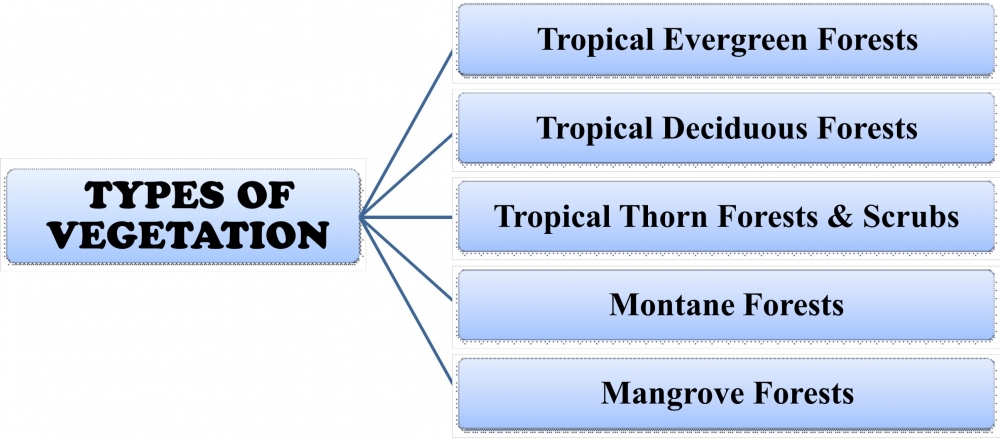
Tropical Rain Forests
(a) The tropical rainforests are confined to areas of heavy rainfall.
(b) Such areas are in the Western Ghats, upper parts of Assam, Tamil Nadu coast and the island groups of Lakshadweep and Andaman & Nicobar.
(c) Areas which receive more 200 cm of rainfall and have a short dry season are the best area for tropical rainforest.
(d) Almost all kinds of vegetation; like trees, shrubs and creepers; are found in such a forest.
(e) The forest has a multilayered structure.
(f) Ebony, mahogany, rosewood, rubber and cinchona are some of the commercially important trees of tropical rainforests.
(g) Elephants, monkey, lemur and deer are the common animals in these forests.
(h) Apart from them, a large number of birds, bats, sloth, scorpions and snails are also found in tropical rainforests.
Tropical Deciduous Forests
(a) Tropical deciduous forests are the most widespread forests of India.
(b) Spread in regions which get rainfall between 200 cm and 70 cm.
(c) They are also called the monsoon forests.
(d) The trees of tropical deciduous rainforests shed their leaves during summer.
(e) These forests can be divided into two types on the basis of availability of water:
1. Moist Deciduous Forest:
(i) The moist deciduous forests are found in areas which receive rainfall between 200 cm and 100 cm.
(ii) Such forests are found mainly in the eastern part of India; like northeastern states, along the foothills of the Himalayas, Jharkhand, West Orissa and Chattisgarh.
(iii) They are also found on the eastern slopes of the Western Ghats.
2. Dry Deciduous Forest:
(i) The dry deciduous forests are found in those regions which receive rainfall between 100 cm and 70 cm.
(ii) Such forests are found in the rainier parts of the peninsular plateau and the plains of Bihar and Uttar Pradesh.
(f) Teak, Bamboo, Sal, Shisham, Sandalwood, Khair, Kusum, Arjun, Mulberry are some of the commercially important trees in these forests.
(g) Lion, Tiger, Pig, Deer and Elephant are the common animals in these forests.
(h) Additionally, a large variety of Birds, Lizards, Snakes and Tortoises are found in these forests.
The Thorn Forests and Scrubs
(a) Thorn forests grow in those regions which receive less than 70 cm of rainfall.
(b) This type of vegetation is found in the north-western part of India, e.g. Gujarat, Rajasthan, Madhya Pradesh, Chhattisgarh, Uttar Pradesh and Haryana.
(c) The main plant species in such a forest are Acacia, Palms, Euphorbias and Cactus.
(d) The trees are scattered and they have long roots which go very deep in the ground.
(e) The stems are succulent to conserve water.
(f) Leaves are usually modified into thorns to prevent evaporation.
(g) Camel, Rats, Mice, Rabbits, Fox, Wolf, Tiger, Lion, Wild Ass, Horse, etc. are the common animals in thorny forests.
Montane Forests
The forests in the mountainous areas are called Montane forest.
Different types of vegetation are found at different altitudes in the mountains:
(a) The wet temperate type of forest is found between a height of 1000 and 2000 meter. Evergreen broad-leaf trees such as Oak and Chestnut abound in such forests.
(b) Temperate forests are found between the heights of 1500 and 3000 meters. Coniferous trees; like Pine, Deodar, Silver Fir, Spruce and Cedar abound in such forests.
(c) Alpine vegetation (temperate forest and grasslands) are found at a height of more than 3600 meters. Silver fir, Junipers, Pines and Birches are the common trees found here.
(d) Above alpine vegetations found are the shrubs and scrubs used for grazing of animals by the nomadic tribes (i.e. Gujjars and Bakarwals).
(e) At the higher altitude Tundra vegetations are found. Mosses and lichens are found here.
Kashmir Stag, Spotted Deer, Wild Sheep, Jack Rabbit, Tibetan Antelope, Yak, Snow Leopard, Squirrels, Shaggy Horn, Wild Ibex, Bear, Rare Red Panda, Sheep And Goats are the common animals in these forests.
Mangrove Forests
Mangrove forests are found in the deltas of the Ganga, the Mahanadi, the Krishna, the Godavari and the Kaveri.
(a) Roots of the mangrove plants are submerged under water.
(b) Hollow roots grow out vertically above water so that roots can breathe.
(c) Sundari tree is the most common tree in such forests; especially in the Sunderban Delta.
(d) Royal Bengal Tiger is the most famous animal of these forests.
(e) Additionally, Turtles, Crocodiles, Gharials and Snakes are found in these forests.

WILD LIFE
(a) There are more than 89,000 animal species in India.
(b) There are more than 1200 species of birds in India.
(c) Elephants are found in the hot wet forests of Assam, Karnataka and Kerala.
(d) One-horned rhinos are found in the swampy and marshy lands of Assam and West Bengal.
(e) Wild ass and camels are found in the Rann of Kachchh and Thar Desert.
(f) Indian Bison, Nilgai, Chousingha, Gazel and many other species of deer and some other animals are found in India.
(g) India is the only country in the world which has both tigers and lions.
(h) There are fourteen biosphere reserves in India.
(i) Four out of these, the SUNDERBANS IN THE WEST BENGAL, NANDA DEVI IN UTTARANCHAL, the GULF OF MANNAR IN TAMIL NADU and the NILGIRIS (KERALA, KARNATAKA AND TAMIL NADU) have been included in the world network of Biosphese reserves.
(j) The fourteen biosphere reserves are: Sunderbans, Gulf of Mannar, the Nilgiris, Nanda Devi, Nokrek, Great Nicobar, Manas, Simlipal, Dihang-Dibang, Dibru Saikhowa, Agasthyamalai, Kanchenjunga, Pachmari, Achanakmar-Amarkantak..
(k) Project Tiger, Project Rhino, Project Great Indian Bustard and many other eco-developmental projects have been introduced.
(l) 89 National Parks, 49 Wildlife sanctuaries and Zoological gardens are set up to take care of Natural heritage.
(m) Wildlife Protection Act 1972.
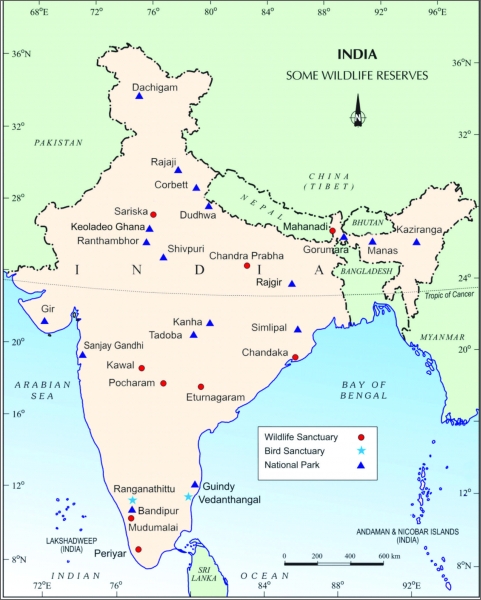
-----x-----X-----x-----

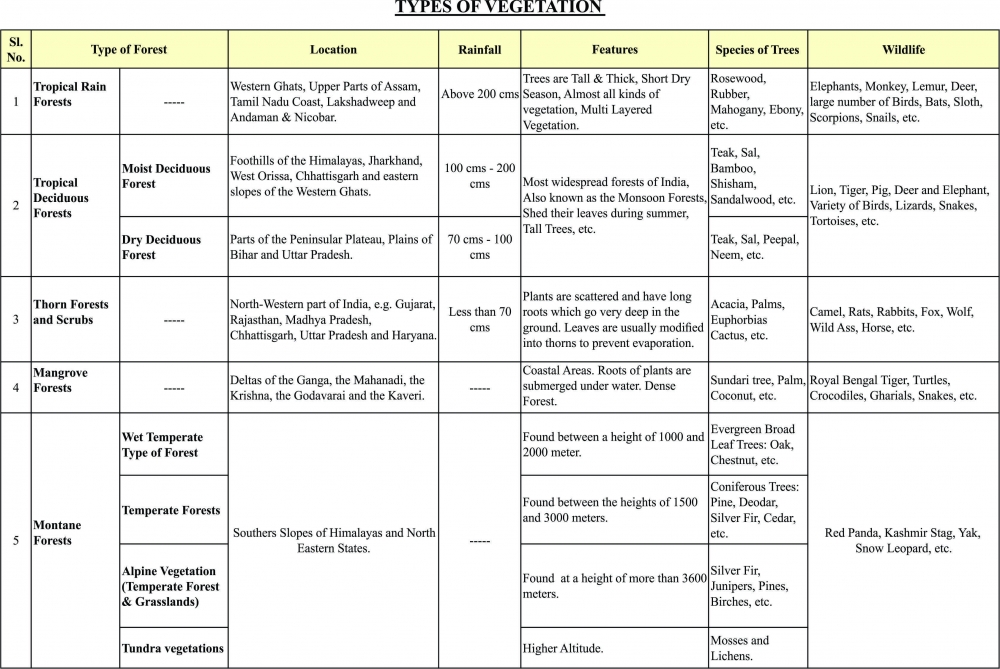
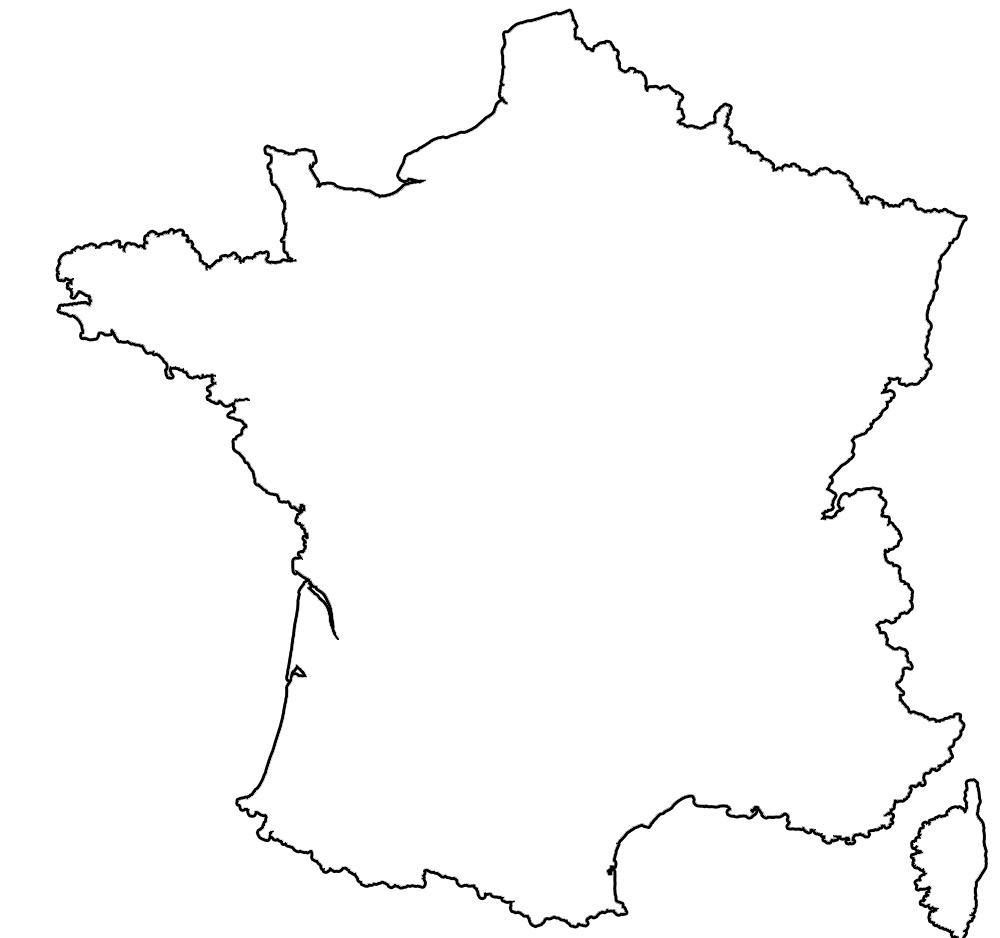
_1_o.jpg)
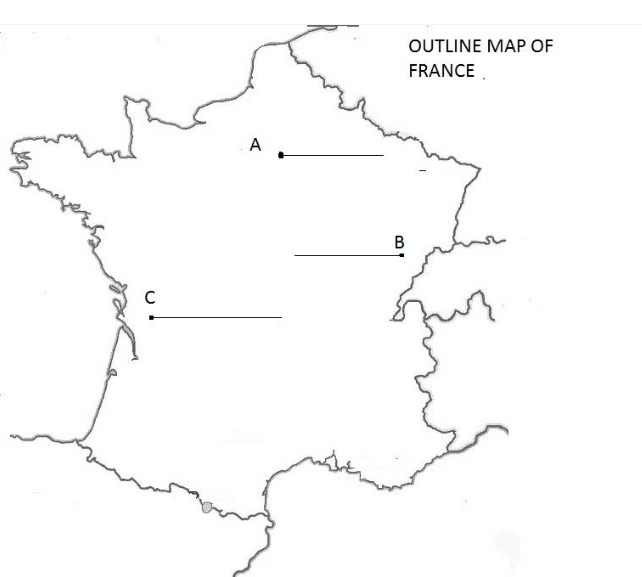
_0_o.jpg)